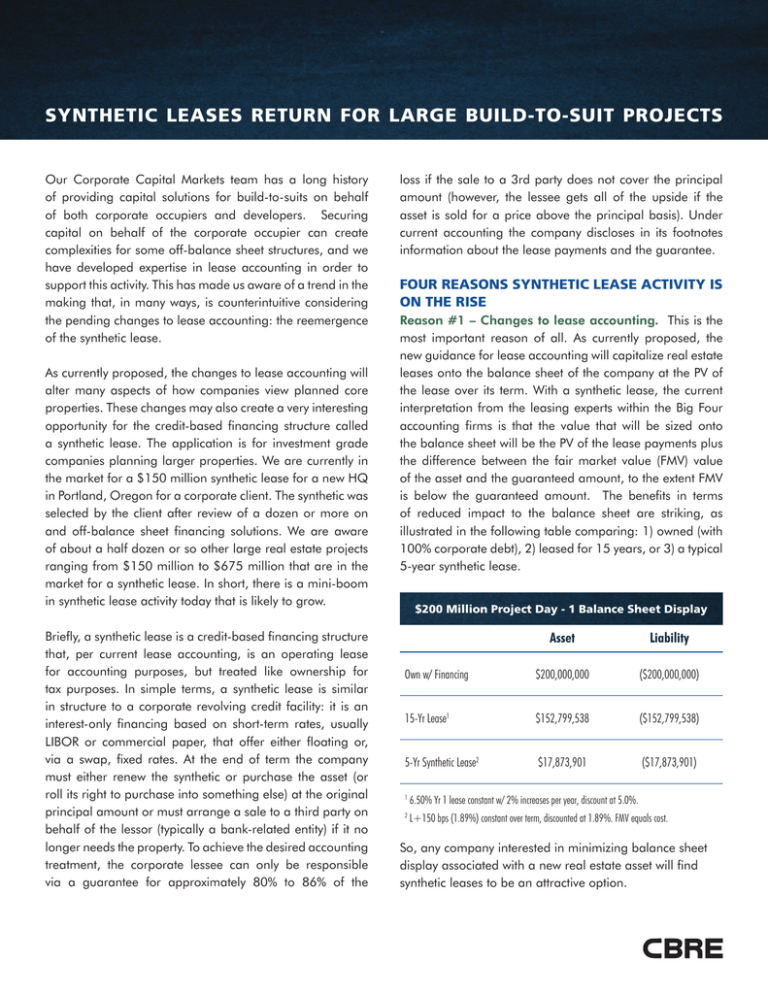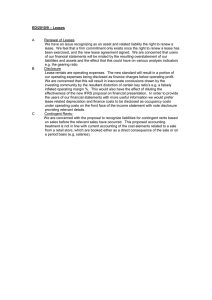synthetic leases return for large build-to-suit projects
advertisement

SYNTHETIC LEASES RETURN FOR LARGE BUILD-TO-SUIT PROJECTS Our Corporate Capital Markets team has a long history of providing capital solutions for build-to-suits on behalf of both corporate occupiers and developers. Securing capital on behalf of the corporate occupier can create complexities for some off-balance sheet structures, and we have developed expertise in lease accounting in order to support this activity. This has made us aware of a trend in the making that, in many ways, is counterintuitive considering the pending changes to lease accounting: the reemergence of the synthetic lease. As currently proposed, the changes to lease accounting will alter many aspects of how companies view planned core properties. These changes may also create a very interesting opportunity for the credit-based financing structure called a synthetic lease. The application is for investment grade companies planning larger properties. We are currently in the market for a $150 million synthetic lease for a new HQ in Portland, Oregon for a corporate client. The synthetic was selected by the client after review of a dozen or more on and off-balance sheet financing solutions. We are aware of about a half dozen or so other large real estate projects ranging from $150 million to $675 million that are in the market for a synthetic lease. In short, there is a mini-boom in synthetic lease activity today that is likely to grow. Briefly, a synthetic lease is a credit-based financing structure that, per current lease accounting, is an operating lease for accounting purposes, but treated like ownership for tax purposes. In simple terms, a synthetic lease is similar in structure to a corporate revolving credit facility: it is an interest-only financing based on short-term rates, usually LIBOR or commercial paper, that offer either floating or, via a swap, fixed rates. At the end of term the company must either renew the synthetic or purchase the asset (or roll its right to purchase into something else) at the original principal amount or must arrange a sale to a third party on behalf of the lessor (typically a bank-related entity) if it no longer needs the property. To achieve the desired accounting treatment, the corporate lessee can only be responsible via a guarantee for approximately 80% to 86% of the loss if the sale to a 3rd party does not cover the principal amount (however, the lessee gets all of the upside if the asset is sold for a price above the principal basis). Under current accounting the company discloses in its footnotes information about the lease payments and the guarantee. FOUR REASONS SYNTHETIC LEASE ACTIVITY IS ON THE RISE Reason #1 – Changes to lease accounting. This is the most important reason of all. As currently proposed, the new guidance for lease accounting will capitalize real estate leases onto the balance sheet of the company at the PV of the lease over its term. With a synthetic lease, the current interpretation from the leasing experts within the Big Four accounting firms is that the value that will be sized onto the balance sheet will be the PV of the lease payments plus the difference between the fair market value (FMV) value of the asset and the guaranteed amount, to the extent FMV is below the guaranteed amount. The benefits in terms of reduced impact to the balance sheet are striking, as illustrated in the following table comparing: 1) owned (with 100% corporate debt), 2) leased for 15 years, or 3) a typical 5-year synthetic lease. $200 Million Project Day - 1 Balance Sheet Display Asset Liability Own w/ Financing $200,000,000 ($200,000,000) 15-Yr Lease1 $152,799,538 ($152,799,538) 5-Yr Synthetic Lease2 $17,873,901 ($17,873,901) 1 6.50% Yr 1 lease constant w/ 2% increases per year, discount at 5.0%. 2 L+150 bps (1.89%) constant over term, discounted at 1.89%. FMV equals cost. So, any company interested in minimizing balance sheet display associated with a new real estate asset will find synthetic leases to be an attractive option. SYNTHETIC LEASES RETURN FOR LARGE BUILD-TO-SUIT PROJECTS Reason #2 – Low-cost financing for quality credits. Synthetic leases offer very low costs of capital compared to other forms of financing for either ownership or leasing. More importantly, they offer 100% construction financing at extremely low rates and, under current accounting for leases, do so in an off-balance sheet structure. In today’s market, major projects with lengthy construction schedules are difficult and expensive to finance, as the following table highlights: $200 Million Project - 30 Month Delivery Schedule Capitalized Interest Expense1 Traditional Lease2 $10,937,500 CTL Lease3 $22,500,000 Synthetic Lease4 $4,725,000 1 assumes average outstanding draw schedule at 50% of cost. 2 assumes 75% loan at 2.5% and equity at 10% contributed pari passu. 3 assumes 4.5% rate on A credit fully funding up front and used for construction. 4 assumes 1.65% rate for A credit. Synthetic leases provide low-cost 100% financing solutions that can significantly reduce the overall cost of a new project or allow more money for investment into the project. Reason #3 – Current lease accounting. Per current accounting, a properly structured synthetic lease will receive off-balance treatment during construction and during the term of lease, which means no asset or liability will be reflected on the financial statements of the company. This will change once all leases are capitalized onto the balance sheet, which currently is expected no sooner than 2017. In the meantime, off balance sheet display is a preferred option for most companies. Reason #4 – Flexibility. Synthetic leases allow the lessee to purchase the asset at any point in time. For some companies, the ability to have off-balance sheet treatment now and either stay in the synthetic lease once the changes occur or easily roll into a new structure when the lease accounting changes are implemented offers the powerful advantage of efficiency and optionality. As discussed earlier, the corporate lessee has the right to purchase the asset at any time for the original cost of the project, regardless of changes to market values. Synthetic leases won’t be for all applications, but should be considered for strong credit companies planning major real estate projects. Evaluating the benefits and the risks of synthetic leases should be part of a thorough review of capital alternatives to own or lease a new corporate facility. CBRE Corporate Capital Markets provides capital markets advisory and execution expertise for planned or existing single-tenant assets on behalf of corporate occupiers, developers and owners. For more information contact: JEFFREY W. SHELL EXECUTIVE VICE PRESIDENT Corporate Capital Markets CBRE, Inc. Tel: 313.417.2100 Email: jeffrey.shell@cbre.com




